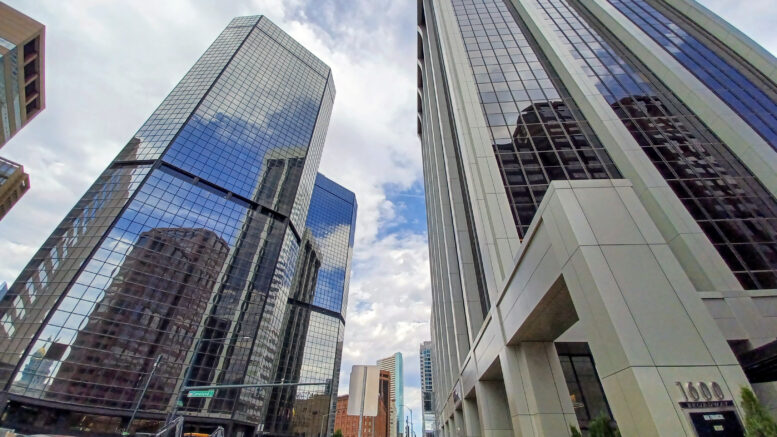After enacting significant rules in recent years to reduce greenhouse gas emissions in the energy and transportation sectors, Colorado will take its first big stab next week at trying to cut them from the buildings sector — a stab that some property owners warn could be a dangerous cut.
Beginning on Aug. 16, the Colorado Air Quality Control Commission will debate the implementation of Regulation 28, a set of building benchmarking and performance standards aimed at reducing greenhouse gas emissions from the sector 7% by 2026 and 20% by 2030. The rules, scheduled for a vote by Aug. 18 after more than 10 hours of planned testimony, would affect any commercial, multifamily or public structure of at least 50,000 square feet — some 8,000 buildings throughout the state, estimated the Colorado Air Pollution Control Division.
Because the cuts are sector-wide rather than on a building-by-building basis, most structures will have to reduce emissions by more than 20% to account for new buildings that will go up in the future and add further emissions. A detailed proposal from the APCD divides affected buildings into 81 property types, with each having their own energy- and greenhouse-gas-intensity targets ranging from those that with the highest allowances (restaurants, bars, convenience stores) to those with the lowest allowances (self-storage facilities, distribution centers, non-refrigerated warehouses).
The rulemaking comes from a 2021 law. It follows efforts by a small number of cities, most notably Denver, to enact local building-performance regulations, though critics note the reductions in energy usage it seeks in sectors like hospitals and medical buildings are more stringent than those from any city or from another state.
“Needed to protect our climate”
Will Toor, executive director of the Colorado Energy Office that will enforce regulations, argued that because buildings are one of the five biggest greenhouse-gas-emitting sectors — along with transportation, oil/gas, electricity providers and industrial uses — efforts like this are needed. An APCD cost-benefit analysis estimates that while the rules will cost building owners $1.77 billion for compliance, they will produce $6.39 billion in savings, most of that from lowered electricity bills over the next 25 years.
“There are some buildings that likely won’t have to do anything because they are so high-performing they already meet the standards that we are proposing,” said Toor in an interview, estimating that 40% of large buildings now meet 2026 standards and 20% meet 2030 numbers. “But it’s one of many things that are needed to protect our climate.”

Colorado Energy Office Executive Director Will Toor speaks at a news conference at the Colorado Capitol.
Amy Jiron, CEO director of building decarbonization, also noted there are many incentives, including those from the federal Inflation Reduction Act and from a state law passed earlier this year, available to boost energy efficiency or install greener energy sources like heat pumps. That makes this the right time for such increased standards, she added.
“Financial crisis”
But those incentives can’t offset a post-pandemic reckoning for office buildings, particularly in urban-core areas, that has left downtown Denver with a 29% office vacancy rate and has left owners of several prominent buildings unable to make loan payments, argued Kathie Barstnar, executive director of commercial real estate association NAIOP. Meeting the new requirements will be expensive, technically challenging and unrealistic on the proposed timeframe, as 80% of buildings will be competing for work in a labor-challenged market — and many will be unable to get loans for it because of their already perilous reductions in rent revenues.
“The building industry is not opposed to improving. But none of what the state is proposing has taken these financial concerns into account,” Barstnar said. “They are positioning themselves to turn a financial concern into a financial crisis.”
To avoid penalties that reach as high as $5,000 per month, building owners must comply with energy-usage- or greenhouse-gas-intensity identified for their property type — or, if unable to do that, must reduce 2021 intensity numbers by 20% by 2026 and 38% by 2030. That standard-percent-reduction pathway was developed to allow an alternative-compliance route for older buildings that will take more time to reach performance levels of newer structures, Toor said.
The path to compliance for buildings

Office buildings like these along Denver’s 16th Street Mall will be affected by the proposed building performance standards.
Regulation 28 proposes a multitude of ways to meet the new standards, ranging from energy-efficiency measures likes adding LED lighting to the replacement of fossil-fuel-powered equipment with high-efficiency electric equipment. It also allows for buildings to offset their emissions through their generation of renewable electricity via a distribution system that is owned or leased by the building operator, though that provision is meeting criticism.
The Environmental Defense Fund, in a pre-hearing statement, said such a clause creates a risk of double-counting emissions reductions as being achieved by both building owners and the utilities that benefit from this generation, and it asked the AQCC to strike the clause. Meanwhile, the Colorado Real Estate Alliance — a coalition that includes groups like NAIOP, the Colorado Building Owners and Managers Association and the Apartment Association of Colorado — argued that the provision is too narrow and should credit building owners for all significant investments they’ve made in renewable energy, even without owning equipment.
But what concerns CREA even more is the specific impact the new regulations could have on hospitals, which are significant energy consumers and are being asked to cut energy usage in a way that will require reductions of 25% by 2030 in at least 17 facilities statewide. The Colorado Association of Healthcare Engineers & Directors estimated it will cost an average facility $44 million to $89.2 million to implement target-level changes by 2043 — not even by 2030 ‑ and the Colorado Hospital Association said in a letter that while members want to reduce energy usage, such cuts can’t come “at the expense of limiting around-the-clock access to care.”
Differing views on costs for building owners
“If I were the Colorado Energy Office, the headline I would fear most would be ‘State hospitals divert funding from patient care to comply with state energy code,’” Barstnar said.
Toor and Jiron said such fears are out of line, noting that Regulation 28 includes myriad ways to achieve compliance as well as the ability to request adjustments if immediate compliance seems impossible. Toor argued that most buildings will be able to achieve at least the percentage-reduction goals by 2030 with “fairly low-cost, marginally operational changes” and that the state’s existing push to upskill workers for new jobs will offset any labor shortages.
But Stephen Shepard, executive vice president of BOMA Denver, noted that most capital plans take four to five years to develop and begin to implement and that 80% of building owners will compete now to hire consultants and work crews for them at the same time. He hopes the AQCC will approve rules less onerous than those proposed — such as the performance law passed by the city of Denver, which also is asking Regulation 28 be no more stringent than its own codes — and that officials understand how difficult compliance will be.
“They always want to talk about ‘the buildings’ as buildings, but every building is as unique as you and me,” Shepard said of the wide range of structures that will need major work. “I think there’s going to be enough places that haven’t achieved the targets by 2030 that it’s going to be an interesting conversation then to see if the state actually enforces the fines.”
